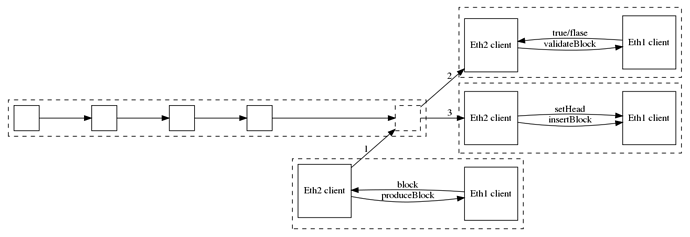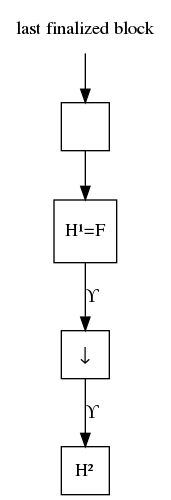This is a proposal for an eth1 engine based on geth, called Catalyst. Thanks to @mkalinin and @djrtwo for their valuable input.
This post presents a general overview of Catalyst, an eth1 engine[1] based on geth.
Catalyst is the name of a fictional device in the Mass Effect series, that triggered the creation of a synthetic foe called the Reapers, who in turn created the Geths.
Architecture
Figure 1: eth1-aware nodes are made of a eth2-eth1 pair in which the eth2 client manages block propagation and the eth1 “engine” manages the state transition.
Each eth1-capable eth2 client has a copy of Catalyst running by its side. They communicate through an RPC API[2]. During its lifecycle, a block goes through four steps:
1 - block production
When the eth2 client determine that it has been elected to produce the next block:
- it calls
produceBlock(head)on its Catalyst instance; - Catalyst produces a new block on top of the specified head block, and returns it to the eth2 client;
- the eth2 client publishes the new block on the eth2 network, to be validated and added to the chain.
Note that if head is not the eth1 chain’s current head, it will return an error.
2 - block validation
When the eth2 client has been selected to validate a block:
- it recovers this block from the network and extracts the eth1 block from it;
- it calls
validateBlockon the eth1 engine with this eth1 block as a parameter; - Catalyst executes this block on top of its current head block and returns
trueupon success andfalseotherwise; - the eth2 client votes for the block validation based on this return value.
Note that since validateBlock is fairly redundant with insertBlock, it might be deprecated after further experimentation with this API.
3 - block insertion
When any eth2 block is published, the eth2 client calls insertBlock on its eth1 engine to have this block added to the chain. The block is processed and is saved to the DB along with its post state.
If the block’s parent is not known, an error will be returned.
4 - setting the head
Every time the eth2 fork choice rule triggers a new head, the eth2 client calls setHead to tell the eth1 engine that this block is the new head of the chain. This might cause a reorg.
Figure 2 in the case where the new head H² is on a different branch than the current head H¹, the heads is rewound from H¹ to the fork point F, and then advanced back to the new head. The new head location is then saved.
When setting the new head H², the eth1 engine will trace back the parent chain, expecting to encounter either:
- the current head H¹; or
- the point at which the chain the new head is on forks from the branch that the current head H¹ is on (hereby called F).
Figure 3 in the case where the new head H² is a direct parent of the current head H¹, F is set to be H¹, and then the transition function ϒ is executed (if necessary) on each block between H¹ to H². Then the new head location is saved.
References
- Danny Ryan’s post on Eth1+eth2 client relationship
- Mikhail Kalinin’s RPC spec document


